Mitsubishi F1M Video - Picture

|
|
Mitsubishi F1M
F1M

Picture - Mitsubishi F1M2 on patrol, c. 1943
Role: Reconnaissance float plane
Manufacturer: Mitsubishi
First flight: June 1936
Introduced: 1941
Primary user: Imperial Japanese Navy
Number built: 1,118
The Mitsubishi F1M (Allied reporting name "Pete") was a Japanese reconnaissance floatplane of World War II. It was the last biplane type of the Imperial Japanese Navy, with 1,118 built between 1936 and 1944. The Navy designation was "Type Zero Observation Seaplane" (é¶å¼æ°´ä¸è¦³æ¸¬æ©), not to be confused with the Type Zero Carrier Fighter or the Type Zero Reconnaissance Seaplane.
Design and development
The F1M1 was powered by the Nakajima Hikari MK1 radial engine, delivering 611 kW (820 hp), a maximum speed of 368 km/h (230 mph) and operating range of up to 1,072 km (670 mi) (when overloaded). It provided the Imperial Japanese Navy with a very versatile operations platform.
Optionally armed with a maximum of three 7.7 mm (.303 in) machine guns (two fixed forward-firing and one flexible rear-firing) and two 60 kg (132 lb) bombs
Operational history

Picture - Damaged F1M2s at Rekata Bay, 1944.
The F1M was originally built as a catapult-launched reconnaissance float plane, specializing in gunnery spotting. However the "Pete" took on a number of local roles including area-defense fighter, convoy escort, bomber, anti-submarine, maritime patrol, rescue and transport. The type fought dogfights in the Aleutians, the Solomons and several other theaters. See also PT 34 sunk 9 April 1942 by "Petes".
Variants
F1M1 : Prototypes. Four built.
F1M2 : Two-seat reconnaissance floatplane for the Imperial Japanese Navy.
F1M2-K : Two-seat training version.
Operators
Indonesia
ABRI (Indonesian Air Force) operated aircraft captured from the Japanese after World War II.
Japan
Imperial Japanese Navy Air Service
Thailand
Royal Thai Air Force
Specifications (F1M2)
Data from Japanese Aircraft of the Pacific War
General characteristics
Crew: two, pilot and rear gunner
Length: 9.5 m (31 ft 2 in)
Wingspan: 11 m (36 ft 1 in)
Height: 4 m (13 ft 1½ in)
Wing area: 29.5 m² (318 ft²)
Empty weight: 1,928 kg (4,251 lb)
Loaded weight: 2,550 kg (5,622 lb)
Max takeoff weight: 2,856 kg (6,296 lb)
Powerplant: 1x Mitsubishi Zuisei 13 14-cylinder two-row radial engine, 653 kW (875 hp)
Performance
Maximum speed: 370 km/h (200 kn, 230 mph) at 3,440 m (11,300 ft)
Range: 740 km (400 nmi, 460 mi)
Service ceiling: 9,440 m (30,970 ft)
Wing loading: 86.3 kg/m² (17.7 lb/ft²)
Power/mass: 2.9 kW/kg (6.85 hp/lb)
Climb to 5,000 m (16,404 ft): 9 min 36 sec
Armament
Guns:
2 x fixed forward-firing 7.7 mm (.303 in) Type 97 machine guns
1 x flexible rearward-firing 7.7 mm (.303 in) Type 92 machine gun
Bombs: 2 x 60 kg (132 lb) bombs
Gallery
Mitsubishi F1M "Pete" biplane/floatplane
Mitsubishi F1M "Pete" biplane/floatplane
Mitsubishi F1M "Pete" biplane/floatplane, rear view
Comparable aircraft
SOC Seagull
Fairey Seafox
Bibliography
Francillon, R.J. Japanese Aircraft of the Pacific War. London:Putnam, 1970. ISBN 370 00033 1.
Green, William. War Planes of the Second World War, Volume Six: Floatplanes. London: Macdonald & Co., (Publishers) Ltd., 1962.
Mitsubishi F1M Pictures
Living Warbirds: The best warbirds DVD series.
Source: WikiPedia